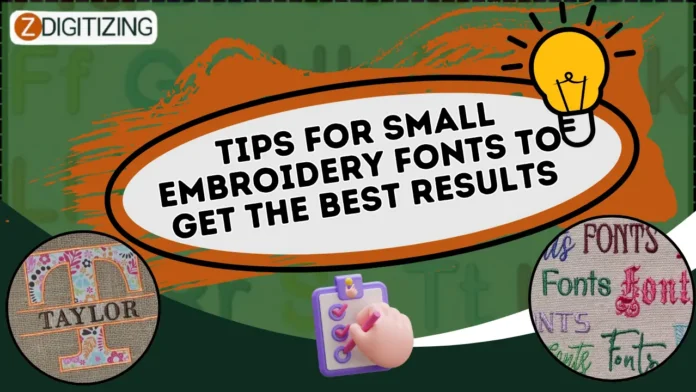Embroidering small fonts can be both challenging and rewarding. Whether you’re adding a name to a delicate baby blanket or monogramming a compact accessory, achieving legible and visually appealing small embroidery fonts requires careful consideration and precision. In this comprehensive guide, we’ll explore a variety of tips to help you navigate the intricacies of small embroidery fonts, ensuring that your text is not only readable but also enhances the overall aesthetic of your project.
I. Introduction
A. Importance of Small Embroidery Fonts
Small embroidery fonts add a personalized touch to various projects, from clothing items to accessories and home decor. However, working with diminutive text requires a different set of techniques to ensure clarity and quality.
II. Choosing the Right Font
A. Font Selection Considerations
- Legibility: Opt for fonts with clear and distinct characters to enhance readability.
- Stitch Density: Choose fonts that are suitable for the fabric and allow for proper stitch density in small sizes.
- Simplicity: Avoid overly intricate fonts, as small details may be lost during embroidery digitizing services.
III. Adjusting Letter Spacing
A. Kerning and Letter Spacing
- Kerning for Readability: Adjust the spacing between individual letters (kerning) to prevent characters from blending together.
- Balancing Act: Find the right balance – too much space can create gaps, while too little can cause letters to merge.
IV. Proper Thread and Needle Selection
A. Thread Weight and Type
- Choose Finer Threads: Opt for finer threads for small fonts to prevent excessive thread buildup.
- Thread Type: Use polyester or rayon threads for their smooth texture, reducing friction during small-scale embroidery.
- Needle Size: Select a needle appropriate for the thread weight and fabric, ensuring precision.
V. Stabilizing the Fabric
A. Importance of Stabilization
- Prevent Distortion: Use the appropriate stabilizer to prevent fabric distortion, especially with lightweight or stretchy materials.
- Hooping Techniques: Proper hooping techniques contribute to stabilizing the fabric and maintaining the integrity of small text.
VI. Adjusting Machine Settings
A. Stitch Length and Density
- Fine-Tune Stitch Length: Adjust stitch length to accommodate small details without compromising on density.
- Avoid Overcrowding: Ensure that the density of stitches is sufficient for clarity without overcrowding.
VII. Test Runs and Samples
A. Trial Embroidery Runs
- Test on Scrap Fabric: Always conduct test runs on scrap fabric with similar characteristics before embroidering on the final project.
- Evaluate Readability: Assess the readability of the text during the test run and make necessary adjustments.
VIII. Color Contrast and Visibility
A. Choosing Suitable Colors
- Contrasting Colors: Opt for colors that contrast with the fabric to enhance visibility.
- Avoid Similar Shades: Steer clear of using thread colors that closely match the fabric color, as this may result in less legible text.
IX. Hoop Alignment and Centering
A. Proper Alignment Techniques
- Centering Text: Ensure that the text is centered within the embroidery hoop for a balanced appearance.
- Avoiding Distortion: Improper alignment can lead to distortion, especially with curved or script fonts.
X. Maintenance of Embroidery Machine
A. Regular Maintenance Checks
- Cleanliness: Keep your embroidery machine clean to prevent thread buildup and ensure smooth operation.
- Needle Checks: Regularly check and replace needles to prevent any damage to delicate fonts.
XI. Stitching Sequence
A. Logical Stitching Order
- Start with Outlines: Begin with outlining the text to define the boundaries before filling in details.
- Logical Sequence: Plan the stitching sequence logically to avoid unnecessary jumps and trims.
XII. Editing Software Features
A. Utilizing Software Capabilities
- Scaling Options: Use scaling options in your embroidery software to adjust font size while maintaining clarity.
- Outline Options: Explore outlining features to enhance the visibility of small text.
XIII. Hand Embroidery Techniques
A. Supplementing with Hand Embroidery
- Backstitching: Use hand embroidery techniques, such as backstitching, to define small details.
- Adding Accents: Incorporate hand-stitched accents for a personalized touch.
XIV. Conclusion
Mastering small embroidery fonts requires a combination of thoughtful font selection, meticulous adjustments, and careful consideration of machine settings. By following these tips, you can elevate your small-font embroidery projects, ensuring that the text is not only legible but also enhances the overall aesthetic of your creations.
Embark on your small-font embroidery journey with confidence, armed with the knowledge to achieve optimal results. Whether you’re monogramming a cherished gift or adding a personal touch to your creations, these tips will guide you towards success.
Zdigitizing
ZDigitizing is offering a wide range of digitizing solutions to meet the needs of vector artwork services businesses and individuals alike. With expertise in logo digitizing, 3D puff digitizing, cap digitizing, and applique digitizing, zdigitizing ensures high-quality and precise embroidery designs.
Their team of skilled embroidery digitizer is well-versed in converting images to embroidery digitizing, making it easy to transform your logos, artwork, or designs into stitch files. Whether you have a PNG or JPG image, ZDigitizing can seamlessly convert it into embroidery-ready files, ensuring accurate reproduction of intricate details and vibrant colors.
ZDigitizing prides itself on delivering quick turnaround times without compromising on quality. They employ state-of-the-art software and machinery to create flawless embroidery designs that bring your vision to life. Their commitment to customer satisfaction, attention to detail, and competitive pricing sets them apart in the embroidery digitizing industry.
FAQs
- Can I use any font for small embroidery projects? While you have flexibility in font selection, choosing clear and legible fonts is crucial for small embroidery projects to ensure readability.
- How do I prevent thread breakage when working with small fonts? Use fine threads, appropriate needles, and ensure proper tension settings on your embroidery machine to minimize the risk of thread breakage.
- Should I hoop stabilizer with the fabric for small fonts? Yes, hooping stabilizer along with the fabric is essential to prevent distortion and ensure stability, especially when working with small embroidery fonts.
- Can I embroider small fonts on stretchy fabrics? Yes, but proper stabilization is crucial when embroidering small fonts on stretchy fabrics to prevent distortion. Use stabilizers suitable for stretch fabrics.
- Are there specific fonts designed for small-scale embroidery? Some fonts are better suited for small-scale embroidery due to their simplicity and legibility. Experiment with fonts designed for embroidery to achieve optimal results.





